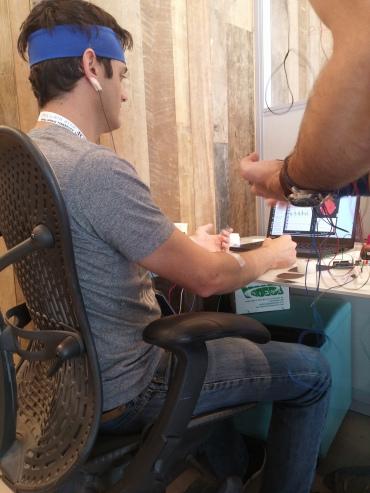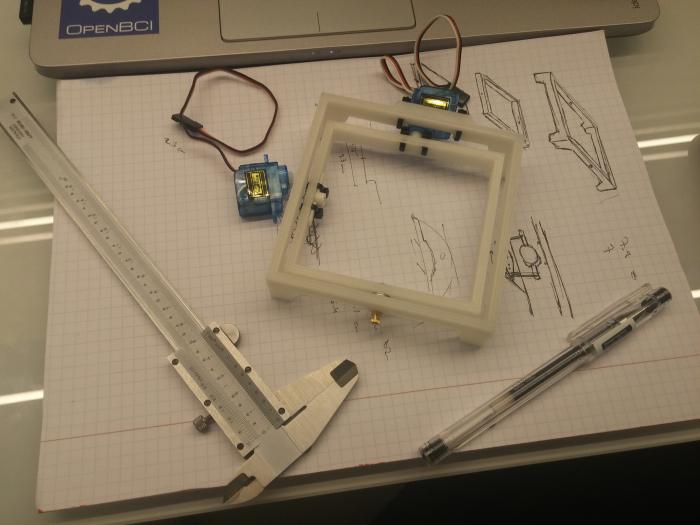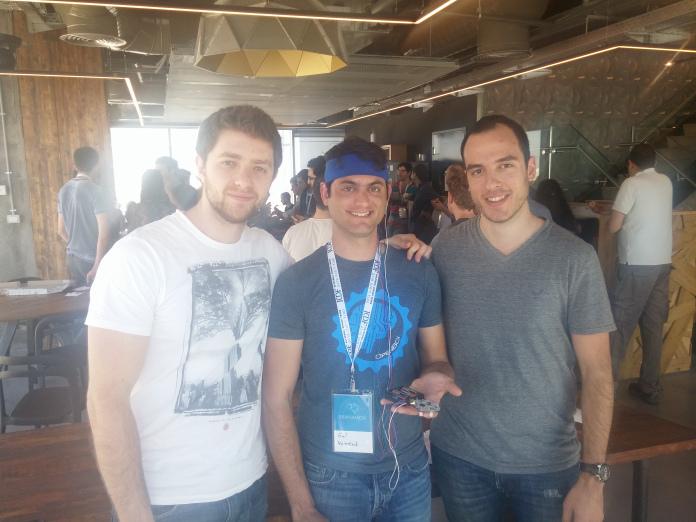 The 3D printed ‘Labyrinth’ takes mind games to the next level of fun, challenge, and — in this case — even winning awards.
The 3D printed ‘Labyrinth’ takes mind games to the next level of fun, challenge, and — in this case — even winning awards.
Participating in the Brainihack 2015 event hosted in Israel by Autodesk last weekend, Daniel Harari, Gal Weinstock, and Maxim Altshul went to the hackathon with absolutely no idea as to what they would create for the competition. To make matters even more interesting, Brainihack is a neuroscience hackathon — and this group has no experience in or specialized knowledge of neuroscience. So, it was quite a wonderful surprise for the group not only to come up with a fun, innovative game, but to also win the coveted and special OpenBCI prize in the ‘open source’ category.
 Harari, Weinstock, and Altshul attended the event as the Blue GSD team. They are two communication systems engineering students and a computer science student. Armed with a smattering of tools, electronic components, and a 3D printer, they walked into the event with enthusiasm, and open minds, and ended up creating a game that undoubtedly would fascinate anyone — neuroscience background or not.
Harari, Weinstock, and Altshul attended the event as the Blue GSD team. They are two communication systems engineering students and a computer science student. Armed with a smattering of tools, electronic components, and a 3D printer, they walked into the event with enthusiasm, and open minds, and ended up creating a game that undoubtedly would fascinate anyone — neuroscience background or not.
Combining Arduino software with EEG technology, the game actually is powered by your brain waves. Labyrinth is completely 3D printed, and the team used OpenBCI, or Open Source Brain-Computer Interface, which is an ‘Arduino based open source bio-sensing microcontroller.’ The students was duly impressed with it, as it was offered as a resource at the hackathon to anyone interested in learning about and using it.
“With OpenBCI we could attach electrodes wherever we wanted (as opposed to some of the other fixed position alternatives) and that way we could experiment with different methods and brain waves and choose the ones that work for us,” said Harari.
After some up-front help from Conor, one of the founders of OpenBCI, which included checking out another project using the technology, they were able to employ the wireless, open-source EEG software in the game. Studying more than one brain wave, they focused on ‘Steady State Visually Evoked Potential,’ where the brain matches a frequency exciting the retina — with blinking lights being a good example of something the brain will match.
Using Alpha and SSVEP waves, the team was able to make the game manageable with one person but they were not able to do it in real-time, as a two-to-three second delay was unpreventable. Because of that, the team simplified the game into a basic maze with two different signals to study — the left side being used to toggle to Alpha waves, and the right being used to toggle up and down for SSVEP. The whole goal is for the 3D printed platform to be moved by the brain waves as they are translated.
The team was able to analyze the data with computer software, where the relevant frequencies are sent to the Arduino, which in turn connects to the servos.
“Movement is provided via two micro servo motors controlled with an Arduino Uno. The mechanism consists of three nested frames that are anchored in different places to achieve two degrees of freedom — roll and pitch,” stated Harari in his project summary.
The Brainihack event is a one and a half day marathon. The teams are forced to think on their feet and act quickly not only to create, but also to problem-solve. The Blue GSD team indeed had to work quickly in bringing together and refining some parts of the Labyrinth game, using items like zip ties and on-the-fly hardware consisting of miscellaneous nuts and bolts to pull the game together. When some very important elements — like the frame — did not work perfectly, they had to improvise. In that instance, they used lifters for the legs.
All the files are available on Thingiverse so that you can download and 3D printing your own Labyrinth game and start using the power of your mind and that of others — for fun. Harari will be uploading the code to GitHub in the near future so others can re-create the full brain-powered experience.
While they may have been ‘armed’ with the tools needed to put together the design, their enthusiasm, coupled with a willingness to learn and take on new technology, ended up in a very rewarding innovation — and earned the team an OpenBCI Starter Kit, which is a $500 retail value.
Are you interested in downloading the files and not only 3D printing, but ‘putting your mind’ to trying out this game combining Arduino software and actual brainwaves? Tell us your thoughts in the 3D Printed Winning Labyrinth Game forum over at 3DPB.com.


Subscribe to Our Email Newsletter
Stay up-to-date on all the latest news from the 3D printing industry and receive information and offers from third party vendors.
Print Services
Upload your 3D Models and get them printed quickly and efficiently.
You May Also Like
Heating Up: 3D Systems’ Scott Green Discusses 3D Printing’s Potential in the Data Center Industry
The relentless rise of NVIDIA, the steadily increasing pledges of major private and public investments in national infrastructure projects around the world, and the general cultural obsession with AI have...
3DPOD 260: John Hart on VulcanForms, MIT, Desktop Metal and More
John Hart is a Professor at MIT; he´s also the director of the Laboratory for Manufacturing and Productivity as well as the director of the Center for Advanced Production Technologies....
Etsy Design Rule Change Reduces Selection of 3D Printed Goods
Online marketplace Etsy has implemented a rule change requiring all 3D printed goods on the site to be original designs. The update to the site’s Creativity Standards states, ¨Items produced using...
E-Beam OEM Wayland Additive Partners with USC Racing to 3D Print Titanium Exhaust Collector
Every year, standards organization SAE International holds a competition called Formula SAE, in which students from both undergraduate and graduate programs design, build, and race small formula-style race cars. For...

































